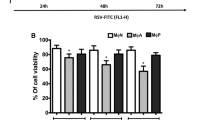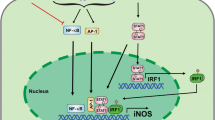Summary
At 5 wk after the intraperitoneal infection of murine cytomegalovirus (MCMV) in adult (C3H/He × BALB/c) F1 (CBF1) mice, MCMV-DNA was noted mainly in the salivary glands (SG). Since graft-versus-host reaction (GVHR) is well known as a major risk factor for CMV reactivation, parental BALB/c spleen cells were then intravenously transferred to these mice to induce GVHR. A high copy number of full-length MCMV-DNA was thus observed in the lungs as well as the hearts and livers at 4 to 6 wk after the cell transfer, whereas the copy numbers in SG after the cell transfer were comparable to those before the transfer. It was therefore suggested that the amount of MCMV-DNA noted in these organs had been increased by GVHR. However, no transcripts of MCMV-DNA could be detected. Since a marked expression of mRNA of inducible nitric oxide synthetase (iNOS) was noted in the lungs and the hearts during the course of GVHR, the role of NO in the increase of MCMV-DNA after the cell transfer was next examined. The administration of L-arginine, a substrate for NO, increased the amount of MCMV-DNA in the lungs and the hearts after the induction of GVHR. In contrast, the material which suppressed iNOS induction inhibited the emergence of MCMV-DNA. Therefore, the NO generated during the course of GVHR increased the amount of the viral DNA in the lungs and the hearts of the mice latently infected with MCMV. If the increase in the amount of viral genome is the initial step of viral reactivation from the latent state, then NO would thus trigger the initial step of the reactivation of the DNA virus. As the lungs are the major organ to produce NO after systemic stimulation, the observations of this study may explain why the lungs are the major site of CMV latency and why GVHR triggers CMV reactivation. These findings are thus considered to demonstrate that NO plays a novel role in viral infection.
Similar content being viewed by others
Author information
Authors and Affiliations
Additional information
Received June 1, 1999/Accepted August 29, 1999
Rights and permissions
About this article
Cite this article
Okada, K., Tanaka, K., Noda, S. et al. Nitric oxide increases the amount of murine cytomegalovirus-DNA in mice latently infected with the virus. Arch. Virol. 144, 2273–2290 (1999). https://doi.org/10.1007/s007050050644
Published:
Issue Date:
DOI: https://doi.org/10.1007/s007050050644




